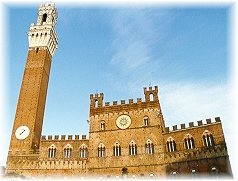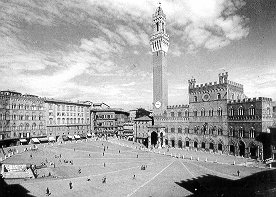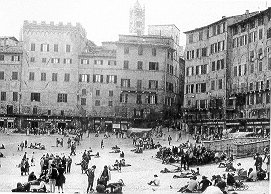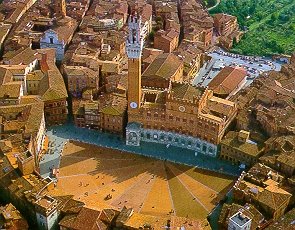 Fra gli esempi
di architettura civile, la piazza del Campo, o meglio "il Campo", come
lo chiamano a Siena, è certamente uno dei più suggestivi
del mondo. Quando fu costruita, all'inizio del Trecento, poteva contenere
l'intera popolazione della città, trasformandosi in luogo di spettacolo,
di giostre cavalleresche, di corse di tori e di bufali. Sul pavimento a
nove settori di mattoni, posti a spina di pesce, si sono svolte da sempre
le manifestazioni pubbliche più importanti. Qui la tipica contrapposizione
tra cattedrale e Palazzo Pubblico assume un carattere più spiccato
per la morfologia del terreno che suggerì una soluzione originale:
essendo ormai sorto il Palazzo Pubblico come sfondo della Piazza del campo,
fu progettato un Duomo nuovo e grandioso, poi non portato a termine, e
per il Battistero fu scelta l'attuale posizione di raccordo, veramente
mirabile, fra le due piazze, col transetto e il coro del Duomo che, sfruttando
il dislivello, sorgono al di sopra del Battistero. I monumenti, i palazzi
e, in primo luogo quello Comunale, con la svettante Torre del Mangia, han
fatto del Campo una struttura unica al mondo, uno spazio aperto che investe
di luce chi vi arriva dagli stertti chiassi circostanti. Fra i mattoni
rossi e le facciate gialline dei palazzi, in gran parte restaurati e modificati
nel corso dei secoli, spiccano le bianche balaustre della Fonte Gaia. Fra gli esempi
di architettura civile, la piazza del Campo, o meglio "il Campo", come
lo chiamano a Siena, è certamente uno dei più suggestivi
del mondo. Quando fu costruita, all'inizio del Trecento, poteva contenere
l'intera popolazione della città, trasformandosi in luogo di spettacolo,
di giostre cavalleresche, di corse di tori e di bufali. Sul pavimento a
nove settori di mattoni, posti a spina di pesce, si sono svolte da sempre
le manifestazioni pubbliche più importanti. Qui la tipica contrapposizione
tra cattedrale e Palazzo Pubblico assume un carattere più spiccato
per la morfologia del terreno che suggerì una soluzione originale:
essendo ormai sorto il Palazzo Pubblico come sfondo della Piazza del campo,
fu progettato un Duomo nuovo e grandioso, poi non portato a termine, e
per il Battistero fu scelta l'attuale posizione di raccordo, veramente
mirabile, fra le due piazze, col transetto e il coro del Duomo che, sfruttando
il dislivello, sorgono al di sopra del Battistero. I monumenti, i palazzi
e, in primo luogo quello Comunale, con la svettante Torre del Mangia, han
fatto del Campo una struttura unica al mondo, uno spazio aperto che investe
di luce chi vi arriva dagli stertti chiassi circostanti. Fra i mattoni
rossi e le facciate gialline dei palazzi, in gran parte restaurati e modificati
nel corso dei secoli, spiccano le bianche balaustre della Fonte Gaia.  Con
questa elegante costruzione i senesi celebrarono l'arrivo dell'acqua in
città, tanto desiderata e oggetto persino di leggende in un ambiente
povero di risorse idriche. Salendo i 400 scalini della torre, detta del
Mangia dal soprannome del campanaro Giovanni di Duccio (il Mangiaguadagni)
si può arrivare ad ammirare uno dei tessuti urbanistici meglio conservati
che esistano in Italia. La piazza non è solo uno scenario urbano;
i senesi vi si recano per scendere al mercato dietro il Palazzo Comunale,
o per parlare con gli amici, per godere del silenzio di una fresca sera
d'estate o per prendere il sole d'inverno, quando la vita nella piazza
rallenta, quasi entrasse in letargo, cessato il flusso dei turisti. Con
questa elegante costruzione i senesi celebrarono l'arrivo dell'acqua in
città, tanto desiderata e oggetto persino di leggende in un ambiente
povero di risorse idriche. Salendo i 400 scalini della torre, detta del
Mangia dal soprannome del campanaro Giovanni di Duccio (il Mangiaguadagni)
si può arrivare ad ammirare uno dei tessuti urbanistici meglio conservati
che esistano in Italia. La piazza non è solo uno scenario urbano;
i senesi vi si recano per scendere al mercato dietro il Palazzo Comunale,
o per parlare con gli amici, per godere del silenzio di una fresca sera
d'estate o per prendere il sole d'inverno, quando la vita nella piazza
rallenta, quasi entrasse in letargo, cessato il flusso dei turisti.
Il Campo è l'immancabile punto di riferimento per ogni manifestazione che interessi la vita pubblica di Siena e quindi è ovvio che la corsa del Palio vi trovi la sua sede più degna. Intanto perchè è un luogo neutro, di tutti, perchè lì si fermano i confini delle 17 contrade e poi perchè la pista coperta di tufo, la grande conchiglia centrale piena di gente e gli altri spettatori sui palchi e alle finestre, formano un insieme che sarebbe impossibile creare altrove.  Eppure
si tratta pur sempre di una cornice poichè, per il contradaiolo,
le cose che contano sono altre e soprattutto il cavallo e il fantino. non
è facile definire cosa sia il Palio; di definizioni ne sono state
date a centinaia. Più facile dire cosa non è: una rievocazione
in costume per esempio, come ce ne sono tante in Toscana. Non che il corteo
che fa da corona alla corsa non sia uno spettacolo di colore e di eleganza,
nel quadro di una iconografia ricca di simboli secolari; ma, anche se non
c'è colore o stemma che non abbia un significato, tutto ciò
è contorno rispetto alla corsa, a quel minuto e mezzo scarso di
intensa passione. Le contrade sono le componenti dell'anima di Siena: esse
guardano ai due appuntamenti del 2 luglio e del 16 agosto come a un momento
essenziale della vita di tutta la comunità senese. Il Palio, quindi,
non ha nulla di finto e basta assistervi almeno una volta per rendersene
pienamente conto. Eppure
si tratta pur sempre di una cornice poichè, per il contradaiolo,
le cose che contano sono altre e soprattutto il cavallo e il fantino. non
è facile definire cosa sia il Palio; di definizioni ne sono state
date a centinaia. Più facile dire cosa non è: una rievocazione
in costume per esempio, come ce ne sono tante in Toscana. Non che il corteo
che fa da corona alla corsa non sia uno spettacolo di colore e di eleganza,
nel quadro di una iconografia ricca di simboli secolari; ma, anche se non
c'è colore o stemma che non abbia un significato, tutto ciò
è contorno rispetto alla corsa, a quel minuto e mezzo scarso di
intensa passione. Le contrade sono le componenti dell'anima di Siena: esse
guardano ai due appuntamenti del 2 luglio e del 16 agosto come a un momento
essenziale della vita di tutta la comunità senese. Il Palio, quindi,
non ha nulla di finto e basta assistervi almeno una volta per rendersene
pienamente conto.  Non
è spirito di competizione soltanto, perchè ciò non
basterebbe a spiegare la complessa attività di contrada che si svolge
durante tutto l'anno e nella quale tutta la vita sociale dei contradaioli
trova un costante riferimento. Intanto bisogna dire che l'attaccamento
alla contrada non ha nulla a che fare con le idee politiche; negli ultimi
trent'anni la situazione sociale di Siena è mutata e anche se il
centro storico si è svuotato in favore dei nuovi quartieri fuori
le mura, non è stata la fine della "senesità". Le contrade
in alcuni casi "dissanguate", hanno continuato a far da costante richiamo
anche a chi ha lasciato le vecchie residenze, mentre la passione contradaiola
ha attecchito a fondo nelle nuove generazioni, sia pure con qualche comportamento
da "tifo" calcistico. Le contrade vivono in funzione del Palio ma il Palio,
a sua volta, prospera per l'intensa vita di contrada, vera comunità
naturale, una delle poche forme associative che sembri non conoscere crisi. Non
è spirito di competizione soltanto, perchè ciò non
basterebbe a spiegare la complessa attività di contrada che si svolge
durante tutto l'anno e nella quale tutta la vita sociale dei contradaioli
trova un costante riferimento. Intanto bisogna dire che l'attaccamento
alla contrada non ha nulla a che fare con le idee politiche; negli ultimi
trent'anni la situazione sociale di Siena è mutata e anche se il
centro storico si è svuotato in favore dei nuovi quartieri fuori
le mura, non è stata la fine della "senesità". Le contrade
in alcuni casi "dissanguate", hanno continuato a far da costante richiamo
anche a chi ha lasciato le vecchie residenze, mentre la passione contradaiola
ha attecchito a fondo nelle nuove generazioni, sia pure con qualche comportamento
da "tifo" calcistico. Le contrade vivono in funzione del Palio ma il Palio,
a sua volta, prospera per l'intensa vita di contrada, vera comunità
naturale, una delle poche forme associative che sembri non conoscere crisi. |
Among the examples of civilized architecture, the Piazza del Campo,
or "the Campo", as it is called in Siena, is certainly one of the most
beautiful in the world. When it was built in the beginning of the
1300's, it could hold the entire population of the city, transforming it
into a place for performances, jousting matches, and bull and buffalo races.
The most important public manifestations have always been held here, on
the nine sections of bricks in the form of a fish spine that form the foundation
of the piazza.
The white banisters of Fonte Gaia (the Fountain of Joy) stand out from the red bricks and yellow facades of palaces of the Campo, most of which have been restored and modified over the centuries. With this elegant construction, the Sienese celebrated the arrival of water in their city, a much desired and even legendary commodity in an environment poor in hydraulic resources. Climbing the 400 stairs of the tower, called "la Mangia" from the nickname of the bell-ringer Giovanni di Duccio (the Mangiaguadagni, or "Earnings-eater"), it is possible to admire one of the best preserved examples of city planning still in existence in Italy. The piazza is not only an urban setting; the Sienese meet there to go down to the market behind the Piazza Pubblico, to talk to friends, to enjoy the silence of a fresh summer evening or to soak up the sun during the winter, when life in the piazza slows down along with the flow of tourists. The Campo is the unfailing point of reference for every event that involves public life in Siena; therefore it is obvious that the race of the Palio finds its most worthy setting there. It is also because the Campo is a neutral zone belonging to everyone, since the boundaries of the 17 "contradas" end there, and because the track covered with soil called tufa, the large, shell-shaped central area full of people, and the other spectators in the bleachers and watching from the windows form a composition that would be impossible to create in any other place. And yet, all of this just forms a frame around the picture, because for the Sienese that belong to the contradas, the most important things are others - most of all the horse and the jockey. It is not easy to define what the Palio is; it has been defined in hundreds of different ways. It is easier to say what it is not: it is not a commemoration in costume, for example, such as are many other events in Tuscany. Not that the procession encircling the race is not a scene of elegance and color in a setting that is an iconography rich with secular symbols; even if there is not one color or coat of arms that does not have a significance, all of these things are extras with respect to the race, to that brief minute and a half of intense passion. The contradas are what make up the soul of Siena: they consider the days of July 2 and August 16 as essential moments in the life of the entire Sienese community. The Palio, therefore, is not to be considered lightly, and it takes seeing it just once to fully realize this. The driving force is not just the spirit of competition, because that would not explain the many, complex contrada activities that take place all year long and in which the social life of the members of the contradas finds a constant point of reference. It is important to note, however, that this attachment to the contradas has nothing to do with political ideas; in the last 30 years the social situation in Siena has changed, and even though the historical center has emptied out in favor of new neighborhoods outside the city walls, this has not meant the end of being truly Sienese. The contradas, in some cases "bled" of their members, have continued to act as a decoy, even to those who have left their old residences, while the passion towards the contrada is deeply rooted in the new generations, sometimes even going as far as behavior similar to that of European soccer fans. The contradas live for the Palio, but at the same time the Palio prospers because of the intensity of life in the contradas, truly natural communities, and one of the few forms of association in which crisis are unknown. |